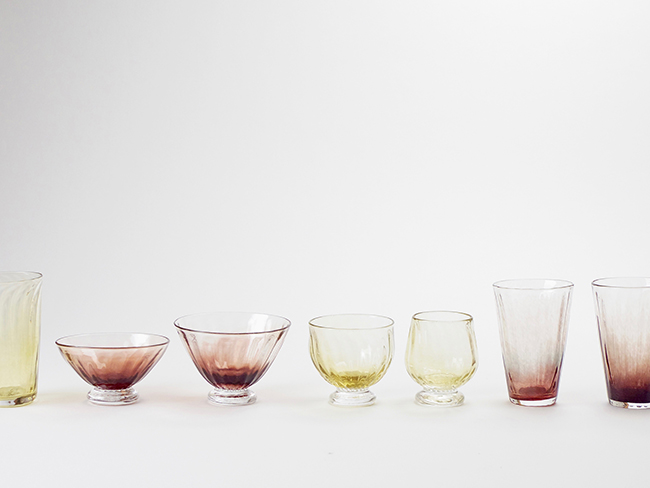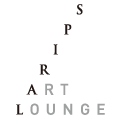Welcome to our ‘spiral market selection’ interview series, where we look at living from the viewpoint of artists and creators engaged in craftsmanship for daily life. For our eleventh interview, we talked with Aki Sakaida who works with glass, making sculptures and tableware.

──Challenging myself at craftsmanship
My family in Akita owns a tableware shop, which probably explains why I’ve always been interested in craftsmanship. At first I got a regular job and started working, but I couldn’t shake the feeling that I wanted to engage in some kind of craft, and one day it occurred to me that I may not have any more chances. I quit the company I was working for and enrolled at art school. After graduating, I became an artist’s assistant in Toyama, where there are many glass artists, and then I joined the Toyama Glass Studio myself. Last year, as I was expecting a baby, I decided to return to my home of Akita, which I’ve now made my production base. I was a late-starter so this is only my twelfth year working with glass.
Nowadays I focus on production while my child is at day care. At first I really struggled with trying to balance my work with child-rearing, but I definitely think that my glass work helps me find balance in daily life. These days I have such limited time for production that I’m better at focusing on it than before. Previously, I’d be content with seven successful pieces from ten attempts at blowing the glass, but now I feel compelled to get a perfect record – ten out of ten. I feel like my success rate is gradually rising.
──Capturing the best form for each piece
Because my pieces are made from blown glass, not molds, it’s almost impossible to make pieces in the same size. In fact, I don’t pay all that much attention to size. That’s not to say I don’t put myself in the shoes of the user. Wanting to please as many people as possible, I was constantly aiming for transparent pieces approximately 12 cm in size, because I had heard previously that they were the most popular and convenient. But focusing on that goal made me gradually lose confidence in my own originality.
If you focus solely on the ideal dimensions, you end up with form that is lifeless. An edge folds over and grows thick…If you don’t get the timing right, you miss that peak, and the glass loses its power. So, I have been changing my mindset to focus on capturing the most beautiful form for a piece without worrying about size.
──Achieving beautiful lines
Glass production is about connecting lines. If the base line is here, where should I make the edge, or finish line? If I connect the base and the edge at this height, I’ll get a small bowl. If I do it here, it will be a drinking glass. It’s the fundamental consideration when blowing glass, no matter the size. I make a point of stopping when the connection of the lines feels good and looks beautiful to me.
I also value the randomness and accidental nature of production. Even if I realize I’ve messed up, I keep working on the piece until it’s done. I like seeing how it spreads differently and how the heat permeates in a new way. It’s like testing. I think it’s really important to build up experiences of what happens in different situations and how to achieve different outcomes. With pieces that haven’t worked out or that crack during cooling, I melt the glass down again and make accessories. It’s really interesting because those pieces show some shades of the tableware piece they were supposed to be.
──Commanding presence
Even when you try to make similar pieces, you sometimes get different outcomes in appearance. The difference might be trivial, but enough to be noticeable. I’m constantly thinking about how to create pieces with a more commanding presence. So, during the production process, I imagine things of beauty and dignity. I especially love the quiet, dignified mood afforded by temples and ceramic pieces, so I make sure to absorb images of those kinds of things. Most often I perceive that ‘mood’ and ‘feel’ in objects made by other people.
The inspiration for an item’s color also comes to me amongst those images, and I’ve recently been making red pieces because I like the strength that color brings. My colour preferences are always changing though, so I expect I’ll be making more colour variations in my pieces going forward.
Glass making, like sport, involves quite a lot of acrobatic moves. I’m told that my movements are very swift during production, but I make a point of ensuring they’re not only fast but also beautiful. You can imagine the kinds of pieces a glassmaker creates by watching their movements. It may seem strange, but one’s movements truly do affect the appearance of the final piece. It’s not something that you can consciously implement; it’s important that it be a natural, everyday thing.
Interview and editing by Spiral

2012 Completed graduate course at Akita Municipal Junior College of Arts and Crafts
2012 Established production base in Toyama City
2017 Left Toyama Glass Studio
2017 Moved production base to Akita City
Instagram ID: akisakaida

Venue: Spiral Market
*The event has ended.





